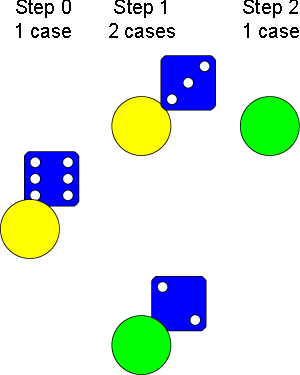Investigating epidemics
Simple models which help us to investigate how epidemics grow and die out.
Project
Why do epidemics take off? Why don't they just carry on for ever once they've started? These simple models will help us to understand what's going on, and how science can help us to prevent epidemics happening in the first place.
Standing Disease
Equipment required: people - lots of them!
- Start with everyone sitting down.
- The first person to be infected with Standing Disease stands up - choose someone. This is step 0.
- They infect two more people - choose them. They also stand up. This is step 1.
- They each infect two more people - choose them from amongst those still sitting. This is step 2.
- Continue until everyone is infected, keeping count of how many steps there are in the epidemic.
Questions to consider:
- How many people in the room? How many steps to infect them all?
- If you repeat the epidemic, will you get the same result?
- What difference would it make if 3 people were infected at each stage? Or more?
- Can you suggest a rule?
- What would happen if the class were bigger, if the whole school took part, for instance? How many steps would it take?
- What about everyone in your town/village?
- What about everyone in the country? Or the world?
- What useful things does this model tell you about how epidemics spread?
- What are its limitations?
Network Disease
Equipment required: people, each with a slip of paper and a pen/pencil, plus optional counters and string
- Before the epidemic starts, everyone should write the names of two people on their piece of paper without discussing their choices.
- Everyone stands up.
- Choose one person to start. This is step 0.
- They choose the two people whose names they have written. They stand up. This is step 1.
- Continue as for Standing Disease, but choosing each time the people written on the piece of paper. If they are already standing, they just remain standing - their names are not substituted for someone not yet standing.
Questions to consider:
- Image

How many steps did the epidemic run for this time?
- Were there any people who were never infected?
- If you repeat the epidemic, will you get the same result? Try it.
- Record the number of steps and the number of people not infected for several runs of the epidemic. What is the average number of steps, and the average number of people infected?
- For one run of the epidemic, draw a network diagram of the connections in the class like the one on the right. Each person is represented with a dot, and a line is drawn between two dots if one person chose the other. You could use counters and string to help you.
- If you were going to vaccinate a small number of people, who would you choose to vaccinate? Why?
- What useful things does this model tell you about how epidemics spread?
- What are its limitations?

Counter Plague
Equipment required: one die and about 20-30 counters per small group (any colour)
- Choose either the blue or red die on the right. The diagrams give you the number of new cases each time you throw your die.
- Place one counter on the table top. This is the first case, and represents step 0.
- Throw the die, and put the appropriate number of counters to the right of the first case. This is step 1.
- Repeat for each infected person at step 1 to see how many new infections there are at step 2, placing the appropriate number of counter to the right of the infecting person (as in the diagram below).
- Repeat until either the epidemic dies out or you run out of counters.
- Record the number of infections at each step on a simple diagram or graph.
- Image

Repeat the epidemic with the same colour die and then see what happens if you use the other die.
- What useful things does this model tell you about how epidemics spread?
What are its limitations?
Questions to consider:
- Does the epidemic take off or die out? Are the results different for the blue die and for the red, or pretty much the same?
- On average, how many steps does the epidemic run for in each case?
- How do you explain your observations?
- Try testing out any theories you have, using your own values for the number of infections corresponding to each result of throwing the die.
- Looking at the number of infections for each outcome on the blue and red dice, do you think that in general an epidemic should be established or die out? Why?
Create your own epidemic model
There are other simple models which help us to explain features of epidemics, and you can find some on our sister website, Motivate.
You may also like to try creating your own model. What features would you like your model to have? Have could you incorporate them in a simple model?
Teachers' Resources
This project contains three simple mathematical models for the spread of an epidemic: Standing Disease, Network Disease and Counter Plague. They are taken from the Disease Dynamics Schools Pack on the Motivate website, where you will find more activities and background material.
What does this project offer your club?
The purpose of a mathematical model is to simplify a real but complex situation so that individual features can be studied more easily. This project provides several models, which could be used for several sessions, to help students understand how epidemics grow and then die out. These models are not meant to be realistic, but give an introduction to mathematical modelling: criticising the models is really important - what features of reality do they help us to understand, what features do they miss?
Possible approach
If you are not a science specialist ...
Studying epidemics is an important aspect of public health. We expect our governments to plan ahead so that when an epidemic occurs, there are plans in place to provide for the needs of both individuals and society generally.
Some epidemics are annoying but not generally life-threatening, such as the common cold or childhood chicken pox. Other epidemics are more serious, such as measles, flu and HIV.
Infectious diseases are transmitted by a variety of methods:
- contaminated water, eg. cholera
- contaminated food, eg. Salmonella infection
- air contaminated by coughing and sneezing, eg. the common cold
- another living organism, eg. mosquitos spread malaria
- direct bodily transfer, eg. HIV
An important parameter in deciding how rapidly an epidemic will escalate and how long it will last is R0, the reproductive ratio or transmission index (different names for the same thing). For the Standing Disease R0 is 2, since each infected person causes two new infections. Any disease where R0 is greater than 1 will escalate, whereas if R0 is less than 1 it will die out. R0 will not remain constant throughout an epidemic, but is a good way of modelling the initial escalation phase.
An important issue in controlling epidemics is that of vaccination. The purpose of vaccination is not to immunise an entire vulnerable population, but to immunise enough people so that R0 is brought below 1. The Network Disease is one way of investigating what effect immunising key individuals would have - the less connected the network, the fewer routes for infection.
It is straightforward to calculate what proportion of a population should be vaccinated. Suppose R0 is 5, meaning that on average each infected person will infect 5 more. Clearly we would expect this to lead to a rapid increase in the number of cases of the illness, and an escalation of an epidemic. However if 4 out of 5 people are immune to the illness, then there will be 5 new cases for 5 existing cases. Vaccinating a little over 80% of the population would be enough to reduce R0 to below 1.
If you are not a maths specialist ...
Mathematical modelling is an important way of tackling problems which are complex and unlikely to yield simple solutions. The point is not to be realistic, but to incorporate some significant features of reality. Too much realism makes a model complicated, too little makes it unhelpful. Modellers generally start with very simple models, then increase the complexity, until what they have is good enough to provide useful information.
The three models in this project are very simple, but do provide useful information.
Standing Disease illustrates how quickly a disease with R0 greater than 1 can take off. It would only take 33 steps for the whole world to be infected if R0 = 2, and there could be perfect transmission from one person to two people at each stage. However, experience tells us that epidemics generally self-limit or become stable in a population (as malaria has in sub-Saharan Africa, for instance).
The Network Disease includes attempted transmission to people who are already ill (and this could also be seen as transmission to people who have become immune), and thus provides a mechanism which shows how transmission of a disease might be constrained.
Counter Plague is a model which incorporates a way of changing R0 in more subtle ways. The blue dice give R0 = 5/6, whereas the red dice give R0 = 7/6. Using the values on the blue dice will mean that in general epidemics die out quite quickly, whereas using the values on the red dice will mean they tend to escalate. These calculations depend on the probability of getting a particular value on a die being 1/6. So for the blue dice:
R0 = 0 x 1/6 + 0 x 1/6 + 1 x 1/6 + 1 x 1/6 + 1 x 1/6 + 2 x 1/6 = 5/6
and for the red dice:
R0 = 0 x 1/6 + 0 x 1/6 + 1 x 1/6 + 1 x 1/6 + 2 x 1/6 + 3 x 1/6 = 7/6
Key questions
How does this model help us to understand real epidemics?
What features of real epidemics does it miss?
Could we improve this model?
Other links
Background: an introduction to the maths behind epidemics, part of the Disease Dynamics Schools' Pack on the Motivate website.
More ideas links to four related simulations which model how an epidemic might progress (or not) in a class or in two classes in a school.
Read: science links to the Maths and Our Health packs on the Motivate website, where you will find videos and classroom resources in five different health science areas.
Health statistician links to an article on Plus about Florence Nightingale, the pioneer of using data to understand and address health issues.
